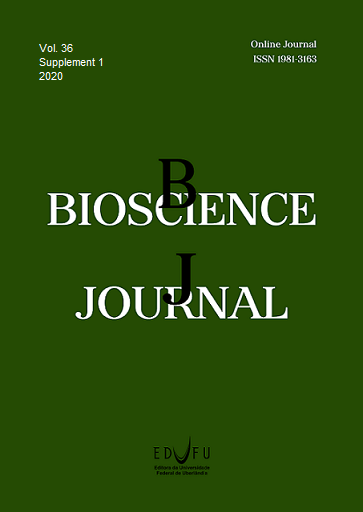Technical feasibility of conventional and nonconventional vegetables’ intercropping under organic fertilization
DOI:
https://doi.org/10.14393/BJ-v36n0a2020-48219Keywords:
Basella alba, Biodiversity, Colocasia esculenta, Lactuca sativa, Sustainable production of neglected vegetables.Abstract
This work aimed to evaluate the technical feasibility of lettuce, Indian spinach and taro intercropping under organic fertilizer. The experiment was performed at Água Limpa Farm, belonging to the University of Brasília, located in Brasília - DF, from October 2014 to June 2015. A completely randomized block design with seven treatments and four replications was used. Each experimental plot had 18 m2 (4.5 m x 4.0 m), totaling 28 plots. The following treatments were assessed: lettuce monoculture, Indian spinach monoculture, taro monoculture, lettuce/Indian spinach intercropping, lettuce/taro intercropping, Indian spinach/taro intercropping, and lettuce/Indian spinach/taro intercropping. In all treatments, the following spacings were used: 0.25 x 0.25 m (lettuce), 1.0 x 0.6 m (Indian spinach), and 1.0 x 0.3 m (taro). Crop production was evaluated from sample plants taken from the central part of each plot. Two harvests of lettuce, two of Indian spinach and one of taro were carried out during intercropping. In the first cycle, lettuce highest mean yield values were observed in the lettuce monoculture (3.5 kg m-2) and lettuce/Indian spinach intercropping (3.4 kg m-2). The crop reached the commercial size in both production cycles, except when intercropped with Indian spinach in the second cycle. The highest Indian spinach mean fresh mass was recorded in the lettuce/Indian spinach intercropping (974.7 g plant-1; first harvest) and monoculture (327.5 g plant-1; second harvest). The yield of taro rhizomes was significantly higher when intercropped with lettuce, showing a mean value of 16.8 kg m-2. The intercropping arrangements with lettuce increased yield of nonconventional vegetables. The conventional and nonconventional vegetables’ intercropping technique increased species diversity in the area without interfering in the agronomic performance and quality of the crops.
Downloads
Published
Issue
Section
License
Copyright (c) 2020 Camila Cembrolla Telles, Ana Maria Resende Junqueira, Yumi Kamila de Mendonça Fukushi

This work is licensed under a Creative Commons Attribution 4.0 International License.





